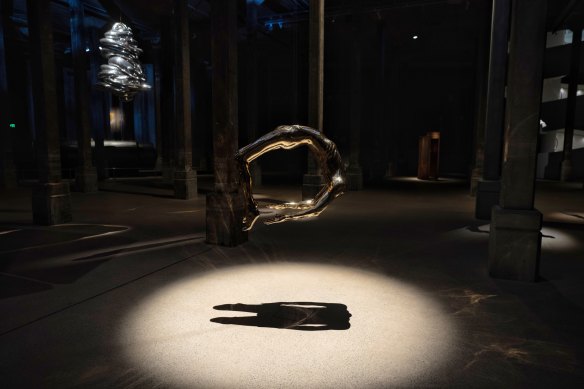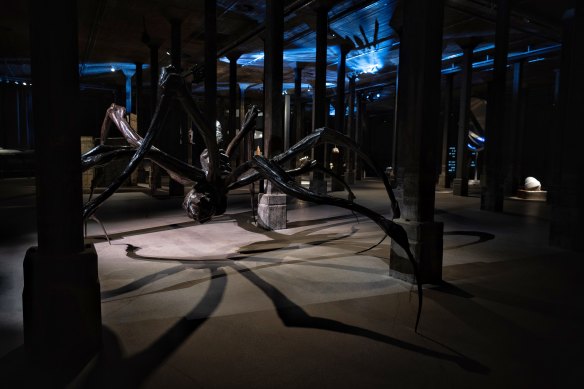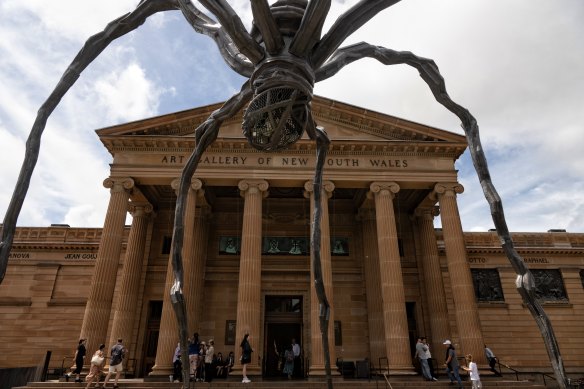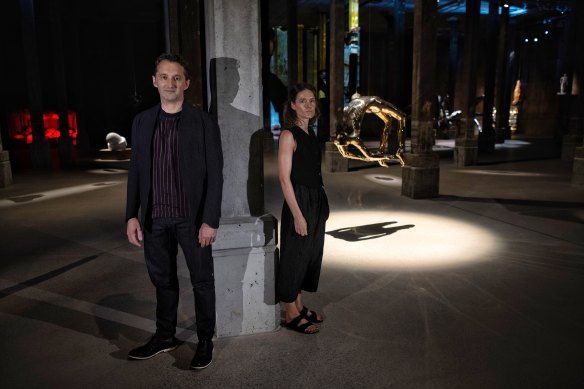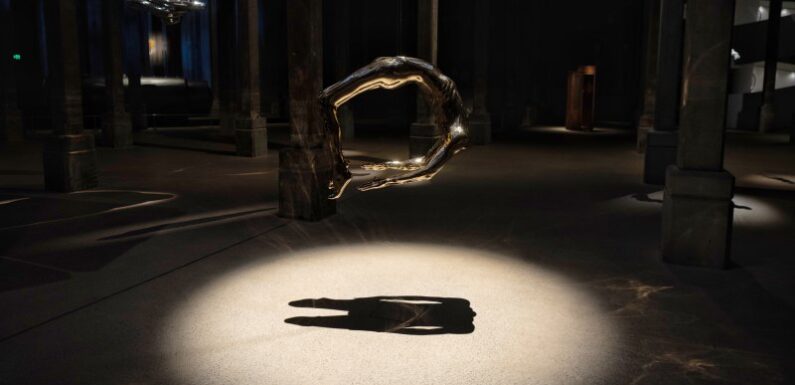
Save articles for later
Add articles to your saved list and come back to them any time.
It’s only taken a year, but Sydney Modern is hosting its first genuine exhibition. Until now, we’ve had rearrangements of the permanent collection, but Louise Bourgeois: Has the Day Invaded the Night or Has the Night Invaded the Day? is a most elaborate first venture. Australia has seen Bourgeois’ work in 1995-96 and 2013, but nothing as wide-ranging as this selection, which features most of the artist’s best-known works, including a version of that monumental bronze spider, Maman (1999), placed like a guardian out the front of the old building.
I’ve encountered that spider in at least four countries and am familiar with many other works from solo and group exhibitions, but with 120 items, this must be one of the largest-ever Bourgeois surveys. It’s impressive in its scale and scope, and in the extreme care taken by curator Justin Paton who has written a catalogue essay and wall labels that go far beyond the usual perfunctory texts. The presentation is so self-consciously literary that it feels slightly precious.
Louise Bourgeois: Has the Day Invaded the Night or Has the Night Invaded the Day? is at the Sydney Modern.Credit: Nick Moir
The lengthy subtitle is taken from one of Bourgeois’s many notes to self, in reference to her persistent delvings into the subconscious. An alternative title might be: Does the show reflect the nature of the building, or the building reflect the nature of the show? Paton and his team have taken advantage of that gloomy, cavernous ex-fuel depot under the building, known as The Tank, to produce an exhibition in two parts: a conventional hang in the well-lit gallery spaces on Level 3, and a theatrical extravaganza in the dungeon.
Bourgeois (1911-2010) was a practicing artist for most of her long life, but her moment of fame arrived late – to be precise, in 1982, when she was given a retrospective at the Museum of Modern Art, New York. From being a cult figure, she rapidly became one of the hottest properties in the contemporary art scene.
Suddenly, there were Bourgeois exhibitions everywhere, as the world’s museums scrambled to make amends for an artist who had been neglected for far too long. The obvious reason for the neglect was that Bourgeois was a woman in a field dominated by men, but perhaps also that her work was too intensely personal and idiosyncratic. As early as 1973, 19 female artists and curators had written to MoMA, petitioning for a major Bourgeois retrospective. It took nine years for their pleas to be heard.
There have now been so many shows all over the world that the AGNSW has had quite the job of coming up with something different. The solution has been to put half the exhibition in the Tank, where it becomes a single installation. Works are spotlit in the darkness, spooky music plays in the background, a Jenny Holzer word piece dominates one wall, videos flicker on all sides. There are no labels to individualise the works. It’s an all-encompassing experience.
My usual impulse is to applaud the bold, innovative installation. Better to take a risk and fail than stick always to a tried-and-true formula. Take for instance, India Mahdavi’s design for the recent Bonnard show at the National Gallery of Victoria. Many felt it was over-the-top, but my criteria for success or failure was whether the design interfered with the appreciation of individual works. I don’t think it did, but the same can’t be said about the Bourgeois works in the Tank.
Louise Bourgeois’s Crouching Spider in the Tank Gallery.Credit: Nick Moir
By losing details, titles and chronology, we mash everything into a Gothic horror show for which the artist has provided the props. There’s no organic reason why works should be upstairs rather than downstairs, as anything could be placed in the basement and appear just as sinister. It’s the nature of the space itself that places limits on the kind of art that can be displayed, and the way it can be shown. Bourgeois’s work fits the bill better than most, but will we eventually get tired of this inflexible ‘haunted house’ aesthetic?
For Bourgeois, making art was an intensely personal affair. Almost all her work – from the smallest sentence scribbled in a notebook, to the giant spider, was a response to her anxieties and personal history. This show is a virtual encyclopaedia of psychoanalytical themes, to the point where we can’t draw a line between art and therapy. Paton quotes Bourgeois’ long-term assistant, Jerry Gorovoy, who said the artist’s mission wasn’t to “make shows”, but to “make it through the day.”
There are many moments in this survey when the viewer feels surplus to requirements, as if Bourgeois were merely addressing herself. She is preoccupied with settling her own demons, not with seducing an audience.
To understand this work we have to learn about Bourgeois’ life, about her parents who repaired and sold tapestries in Paris; about the unhappy relationship between her father and mother, and the English governess with whom her father had a long-running affair. These characters – by turns loved and hated – play crucial, hidden roles in the drama of Bourgeois’s creative output. The spider is “maman”, both a towering monster and a being who weaves and repairs. The Destruction of the Father (1974) in the Tank, is simultaneously a landscape and the remains of a cannibal feast, bathed in a lurid red light. The myth of the sons who kill and eat the tyrannical father is raised in Freud’s Totem and Taboo (1912-13) which Bourgeois would surely have read.
Louise Bourgeois’s Maman in the forecourt of the Art Gallery of NSW.Credit: Nick Moir
Most of Bourgeois’s sculptures have a sexual dimension, although they may take monstrous forms, as in Fillette (sweeter version) (1968-99), a lumpen phallus that dangles from the ceiling. The title in French, means “little girl”. In The Couple (2003), two spiralling figures in stainless steel clutch at each other as they revolve in space. In Arch of Hysteria (1993), a headless figure is twisted backwards into a circle, in an act of torture and an extraordinary feat of contortionism.
The interpretations in the catalogue lean heavily into the psychoanalytical aspects, but barely mention that Bourgeois’s husband, art historian, Robert Goldwater (1907-73) was the inaugural director of the Museum of Primitive Art, New York, and wrote extensively on the subject. We shun the term “primitivism” nowadays, but there’s no denying the debt modernists owed to the works of tribal artists. That debt is clear in seminal paintings such as Picasso’s Les Demoiselles d’Avignon (1907), but also in Bourgeois’s wooden Personages of the late 1940s and in the sewn heads and dolls she made later in life.
There are at least 15 Personages on Level 3, clustered in a single gallery-like marker in a graveyard. Their different characters suggest they are portraits of people of importance to Bourgeois.
Curators Justin Paton and Emily Sullivan.Credit: Nick Moir
The textile figures that came along in the 2000s closely resemble the fetishes one finds in African tribal sculpture. Even in museums those pieces retain an eerie power that testifies to their magical origins. Bourgeois’s dollies have similar overtones of voodoo, as if she might have stuck pins in them to hurt her enemies or used them as charms to ward off evil spirits. They are relentlessly creepy, none more so than the pink fabric head in The Hidden Past (2004), that hangs upside down inside a darkened closet.
These grotesque images may have grown out of the fears and agonies of childhood, but Bourgeois could never stop making them. Through years of depression, chronic insomnia, sadistic urges, rage and remorse, Bourgeois retained her sanity through the methodical production of sculptures, drawings and paintings. She found ways of giving concrete form to the thoughts that stirred uneasily in the subconscious.
There may be moments of striking beauty in Bourgeois’ creations, but her personal theatre of the absurd is generally not pretty. The way this show has been laid out, in a mannered confrontation between darkness and light, makes one feel like an intruder in another person’s fantasies. There’s a frisson in all this artifice and melodrama, but it’s hard to escape the feeling something is lurking below the surface that you really don’t want to meet.
Louise Bourgeois: Has the Day Invaded the Night or Has the Night Invaded the Day? is at the Art Gallery of NSW until April 28.
Most Viewed in Culture
From our partners
Source: Read Full Article
